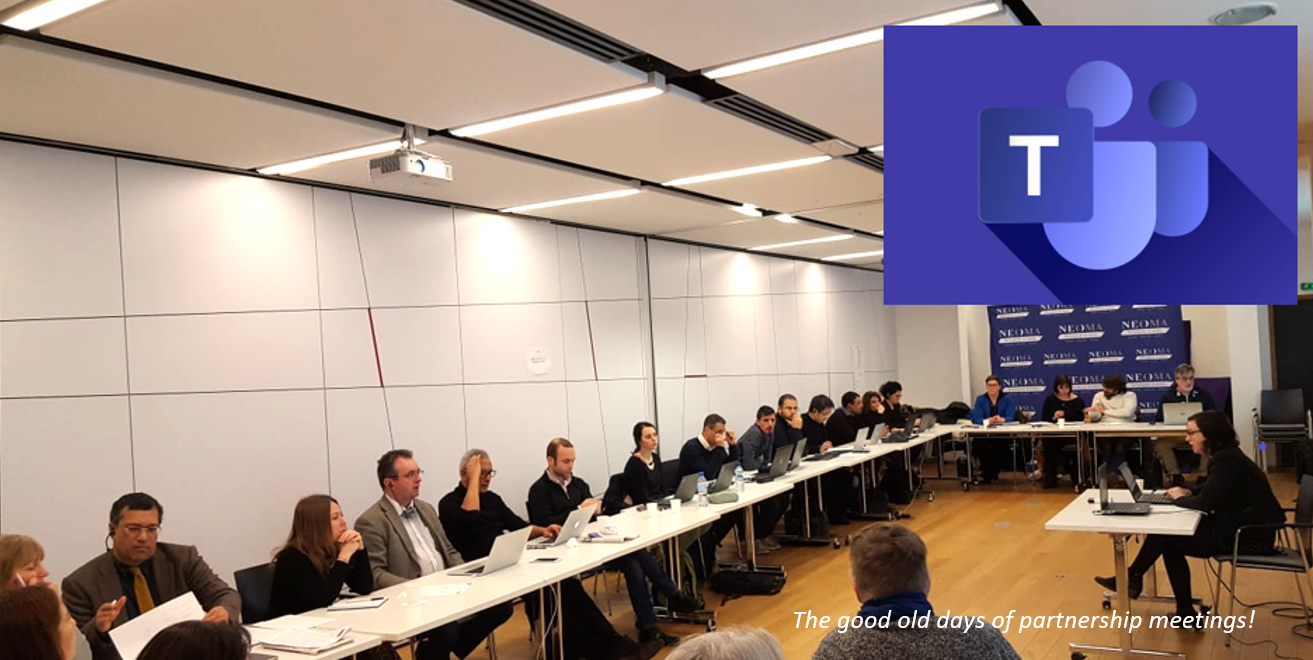Interpretation for virtual meetings

Remote meetings have become commonplace over the past few months. But what happens when participants do not speak the same language? In the context of the France Channel England project, the assistance of an interpreter is sometimes necessary, especially for long sessions.
Until the beginning of 2020, VISTA partners used to gather around the same table four times a year at one of the partner sites for quarterly meetings (QMs). However, the announcement of ‘lockdown’ forced the organisers to quickly rethink their interpretation system.
After a lot of research and two virtual Partnership meetings, we thought it would be useful to share our experience.
What were the constraints that had to be taken into account?
– The impossibility, even for residents of the same country, to be present in the same room due to travel restrictions.
– Budgetary limitations. Interpretation systems can be expensive.
– Technical issues, of course.
For the first online QM, the 30 participants were invited to connect to Microsoft TEAMS – the meeting channel – and MS Translator, an online program with automatic written translation.
How does MS Translator work?
1. The login code had to be resent more than once because participants, depending on their status on MS TEAMS (guest or member), did not have access to the same functions. A ‘guest’ could not follow the meeting channel ‘chat’ for example.
2. Some people could not connect with their browser.
3. Bilinguals sometimes forgot to speak in the language they had originally selected.
4. Some forgot to mute themselves when someone else was speaking or the speaker was muted by the organiser by mistake.
The organiser, having generated the meeting code, must have access to the transcript with the different languages attendees had selected.
What happens if points 3 and 4 are combined? The translator cannot identify who is speaking, nor the language being spoken, and tries to interpret sounds. The result is this:
Extract from the meeting:

Although it was all in all quite a fun experience, we decided to look for a slightly more reliable solution for the July meeting, combining technology with human skills, using real interpreters.
As with the April QM, it was advisable to develop a procedure outlining all the steps to be followed and the rules to be established in order to make the meeting run as smoothly as possible.
For this QM, each participant needed to equip themselves with a computer to follow the TEAMS meeting on the main channel and download the app to an independent device (smartphone, tablet or computer) for the interpretation channel. This system is very easy to use once the meeting has started but requires technical preparation beforehand.

To limit last-minute technological inconveniences, 30 minutes before the meeting were spent installing the equipment and carrying out technical tests.
Despite a few unavoidable problems (no wifi, forgetting or misconnecting to one of the two meeting channels), this system proved to be very efficient. We were lucky to have two very good interpreters with us over two days and were better prepared.
This system is also fully adaptable to multilingual meetings, with more than two languages. It only requires sending a separate invitation for each interpretation channel.

Our suggestions :
• A piece of advice; teleconference meetings over several days are very physically demanding, as they require a great deal of concentration while you have to sit in front of a screen for hours on end. This is why it is strongly recommended that you take regular (hourly) breaks of about 15 minutes and at least one hour for lunch.
• On the choice of the mode of interpretation, if you decide to go for the second option, and use interpreters:
– Always remember to record each sequence of meetings (1 or 2 hours for example) independently, depending on the agenda. This is lighter to download and makes it easier to find your way around.
– It is not possible to download the recording of a meeting followed on the phone or tablet. If you have two computers, it is advisable to install MS TEAMS on both devices in order to be able to record the main meeting and the interpretation meeting.
• The MS Translator system can be useful for short, small meetings if everyone follows the instructions exactly and articulates them very clearly.
– The MS TEAMS/Interpreter solution is adaptable to large meetings with up to 100 participants, if not more.
There are other methods or platforms (eg.VoiceBoxer, Transperfect, Interprefy, etc.), but for those looking for quick, low-cost solutions, Microsoft TEAMS and these two systems are a good alternative to physical meetings.
To those interested in learning more about the use of MS TEAMS, here is a link towards explanatory and online training videos: Microsoft Teams video training.
